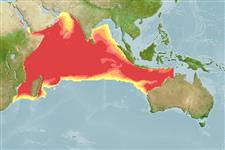Klassifizierung / Names
Namen | Synonyme | Catalog of Fishes(Gattung, Arten) | ITIS | CoL | WoRMS | Cloffa
>
Stomiiformes (Lightfishes and dragonfishes) >
Phosichthyidae (Lightfishes)
Etymology: Ichthyococcus: Greek, ichthys = fish + Greek, kokkos = grain, berry (Ref. 45335); parini: Named after N.V. Parin, in honor of his work on oceanic fishes (Ref. 44179).
Eponymy: Professor Dr Nikolai Vasilyevich Parin (1932–2012) of the P. [...] (Ref. 128868), visit book page.
Environment: milieu / climate zone / depth range / distribution range
Ökologie
seewasser bathypelagisch; tiefenbereich 0 - 985 m (Ref. 44179). Deep-water
Indian Ocean: southern Arabian Sea, Bay of Bengal, and around Sri Lanka.
Size / Gewicht / Alter
Maturity: Lm ? range ? - ? cm
Max length : 4.9 cm SL Männchen/unbestimmt; (Ref. 44179)
Kurzbeschreibung
Bestimmungsschlüssel | Morphologie | Morphometrie
Rückenflossenstacheln (insgesamt) : 0; Rückenflossenweichstrahlen (insgesamt) : 12 - 13; Afterflossenstacheln: 0; Afterflossenweichstrahlen: 14 - 16.
Life cycle and mating behavior
Geschlechtsreife | Fortpflanzung | Ablaichen | Eier | Fecundity | Larven
Mukhacheva, V.A., 1980. A review of the genus Ichthyococcus Bonaparte (Photochthyidae). J. Ichthyol. 20(6):1-14. (Ref. 44179)
IUCN Rote Liste Status (Ref. 130435: Version 2024-1)
Bedrohung für Menschen
Harmless
Nutzung durch Menschen
Tools
Zusatzinformationen
Download XML
Internet Quellen
Estimates based on models
Preferred temperature (Ref.
123201): 9.6 - 20.7, mean 13.1 °C (based on 193 cells).
Phylogenetic diversity index (Ref.
82804): PD
50 = 0.5078 [Uniqueness, from 0.5 = low to 2.0 = high].
Bayesian length-weight: a=0.00955 (0.00400 - 0.02282), b=3.06 (2.85 - 3.27), in cm total length, based on LWR estimates for this (Sub)family-body shape (Ref.
93245).
Trophic level (Ref.
69278): 3.2 ±0.4 se; based on size and trophs of closest relatives
Widerstandsfähigkeit (Ref.
120179): hoch, Verdopplung der Population dauert weniger als 15 Monate. (Preliminary K or Fecundity.).
Fishing Vulnerability (Ref.
59153): Low vulnerability (10 of 100).
